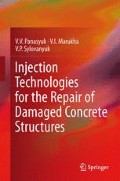Abstract
The subject of this chapter is the effect of main corrosive air and/or water environment factors on strength of structural concrete and reinforced concrete during long-term operation. Specific destructive action of static and/or cyclic loads and induced complex deformations on processes of concrete damage and fracture is considered. Included case studies characterize decrease in concrete strength and load-carrying capability due to intense corrosion processes occurring on its surface and/or bulk. The specific effect of aggressive gas environments causing discontinuity of concrete’s heterogeneous structure and nucleation of defects such as cracks, laminations, cavities or others is characterized. Outline and characterization of principal biological and microbiological factors affecting the concrete injury in practice are given. Basic kinds of stress corrosion degradation causing thinning and load-bearing capacity diminishment of steel reinforcing wires in concrete are covered. The authors present analysis of combined effects of static/cyclic mechanical loads and corrosive air and/or water environment on injury and fracturing of concrete structures and constructions over long-term operation.
Access this chapter
Tax calculation will be finalised at checkout
Purchases are for personal use only
Notes
- 1.
The term ‘structures’ hereinafter implies concrete or reinforced concrete structures, except when otherwise specified.
References
Moskvin VM (1952) Korroziya betona (The concrete corrosion). Goslitizdat, Moscow
Moskvin VM, Ivanov FM, Alexeev SN, Guzeyev EA (1980) Korroziya betona i zhelezobetona, metody ih zashchity (Concrete and reinforced concrete corrosion and protective methods). Stroyizdat, Moscow
Collins JA (1981) Failure of materials in mechanical design: analysis, prediction, prevention. Wiley, New York
Popov TN (1986) Zhelezobetonnyye konstruktsii, podverzhennyye deystviyu impulsnykh nagruzok (Reinforced concrete structures subjected to pulse loads). Stroyizdat, Moscow
Biokorroziya, biopovrezhdeniya, obrastaniya (1976) (Biocorrosion, biodamages, fouling). CNIISK, Moscow
Ivanov FM, Gorshin SN, Waite J et al (1984) Biopovrezhdeniya v stroitelstve (Biodamages in construction). Stroyizdat: Moscow
Ahverdov IN (1981) Osnovy tehnologii betona (Basics of concrete technology). Stroyizdat, Moscow
Bazhenov BA (1979) Ispytaniya materialov, izdeliy i konstruktsiy (Testing of materials, elements, and structures). GGU, Gorky
Alexandrovsky SV, Bagriy VY (1970) Polzuchest’ betona pri periodicheskikh vozdeystviyakh (Concrete creep under periodic loads). Stroyizdat, Moscow
Berg OY (1961) Fizicheskiye osnovy prochnosti betona i zhelezobetona (Physical fundamentals of concrete and reinforced concrete strength). GSI, Moscow
Arutunyan NH (1952) Nekotoryye voprosy teorii polzuchesti betona (Some problems of concrete creep theory). Stroyizdat, Moscow
Bazhenov YM (1970) Beton pri dinamicheskom nagruzhenii (Concrete under dynamic loading). Stroyizdat, Moscow
Kolokol’chikova EN (1975) Dolgovechnost’ stroitelnykh materialov: Beton i zhelezobeton (Durability of building materials: Concrete and reinforced concrete). Vyssh shkola, Moscow
Alexeev SN, Ivanov FM, Mordy S, Shisil P (1990) Dolgovechnost’ zhelezobetona v agressivnykh sredakh (Durability of reinforced concrete in aggressive environments). Stroyizdat, Moscow
Moskvin VM, Alexeev SA, Verbitskiy GP, Novgorodskiy VI (1971) Treshchiny v betone i korroziya armatury (Cracks in concrete and corrosion of reinforcement). Stroyizdat, Moscow
Baikov VN, Sigalov EE (1984) Zhelezobetonnyye konstruktzii (Reinforced concrete structures). Stroyizdat, Moscow
Grunau EB (1973) Verhinderung von Bauschaden (Prevention of defects in building structures). Muller, Koln-Braunsfeld
Panasyuk VV, Ratich LV, Dmitrakh IM (1983) Dependence of fatigue crack growth rate in aqueous corrosive environment on electrochemical conditions in the crack tip. Phys Chem Mech Mater 4:33–37
Alexeev SK (1973) Korroziya i zashchita armatury v betone (Corrosion and reinforcement protection in concrete). Stroyizdat, Moscow
Trapeznikov LP (1986) Temperaturnaya treshchinostoikost’ massivnykh betonnykh sooruzheniy (Temperature fracture toughness of bulk concrete structures). Energoatomizdat, Moscow
Gvozdev AA (ed) (1978) Prochnost’, strukturnyye izmeneniya i deformatsii betona (Strength, microstructure transformations, and deformations of concrete). Stroyizdat, Moscow
Grushko IM, Illyin AG, Chikhladze ED (1986) Povysheniye prochnosti i vynoslivosti betona (Advance in concrete strength and durability). Vyssh shkola, Moscow
Zaitsev YV (1982) Modelirovaniye deformatsiy i prochnosti betona metodami mekhaniki razrusheniya (The concrete deformations and strength simulation using fracture mechanics methods). Stroyizdat, Moscow
Author information
Authors and Affiliations
Corresponding author
Rights and permissions
Copyright information
© 2014 Springer Science+Business Media Dordrecht
About this chapter
Cite this chapter
Panasyuk, V., Marukha, V., Sylovanyuk, V. (2014). Predominant Damages and Injuries in Reinforced Concrete Structures Arising During Use. In: Injection Technologies for the Repair of Damaged Concrete Structures. Springer, Dordrecht. https://doi.org/10.1007/978-94-007-7908-2_3
Download citation
DOI: https://doi.org/10.1007/978-94-007-7908-2_3
Published:
Publisher Name: Springer, Dordrecht
Print ISBN: 978-94-007-7907-5
Online ISBN: 978-94-007-7908-2
eBook Packages: EngineeringEngineering (R0)

